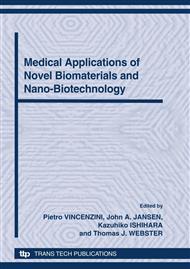p.214
p.224
p.229
p.235
p.240
p.247
p.253
p.259
p.264
Creation of Superelastic Functional Properties in a Ti-50.7%Ni Wire for the Stapler Suturing of Blood Vessels
Abstract:
The technique of aorta-coronary shunting offered by Dr. M. Soutorine by means of the original stapler developed by "Endogene" allows suturing blood vessels by superelastic Тi-Ni staples on «working heart» (without heart switching-off). The material for staples is a 0.30 and 0.315 mm diam. wire which was studied by DSC, shape recovery and mechanical tests. Thermomechanical treatment (TMT) comprised warm drawing, low- temperature (LTMT) by cold drawing with 25-30% strain in the last pass and following post-deformation annealing (PDA). LTMT leads to increasing of yield stress in comparison with warm drawing. Treatment of wire under LTMT+PDA allows obtaining the highest characteristics of functional properties of the wire. The difference between “dislocation” and “transformation” yield stresses Δ=900 MPa. Critical stress of superelastic recovery after TMT on the average is 1.5-2 times higher in comparison with warm drawing. The maximum completely recoverable strain r,1max=6.5%. The maximum obtained force value of staples is РrSE=6.5 Н. The shape recovery rate of staples was 85-97 % that provided its functionality. Storage in the stapler in straightened condition within 1 month does not worse the staples.
Info:
Periodical:
Pages:
253-258
Citation:
Online since:
October 2010
Authors:
Price:
Сopyright:
© 2010 Trans Tech Publications Ltd. All Rights Reserved
Share:
Citation:


